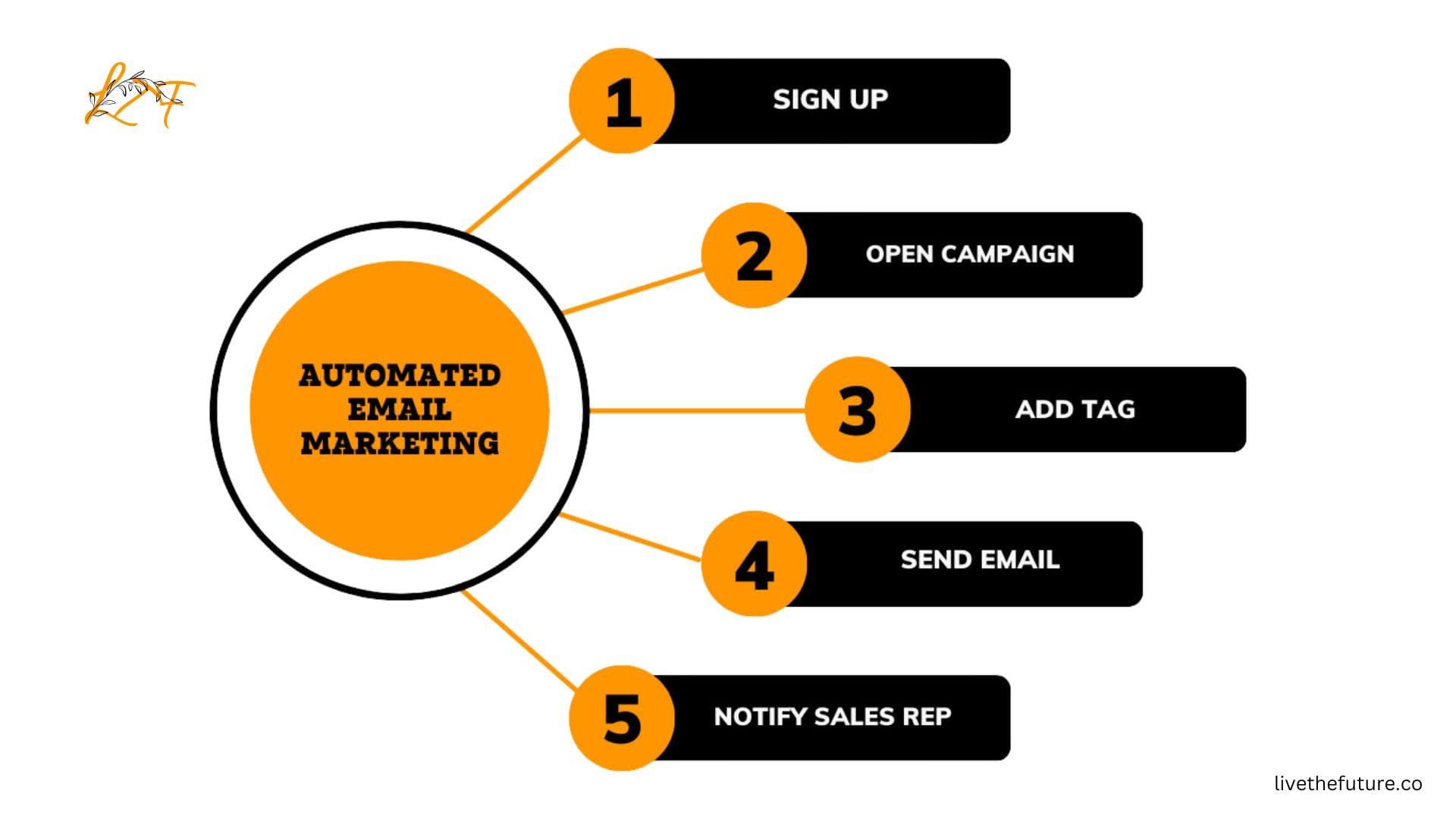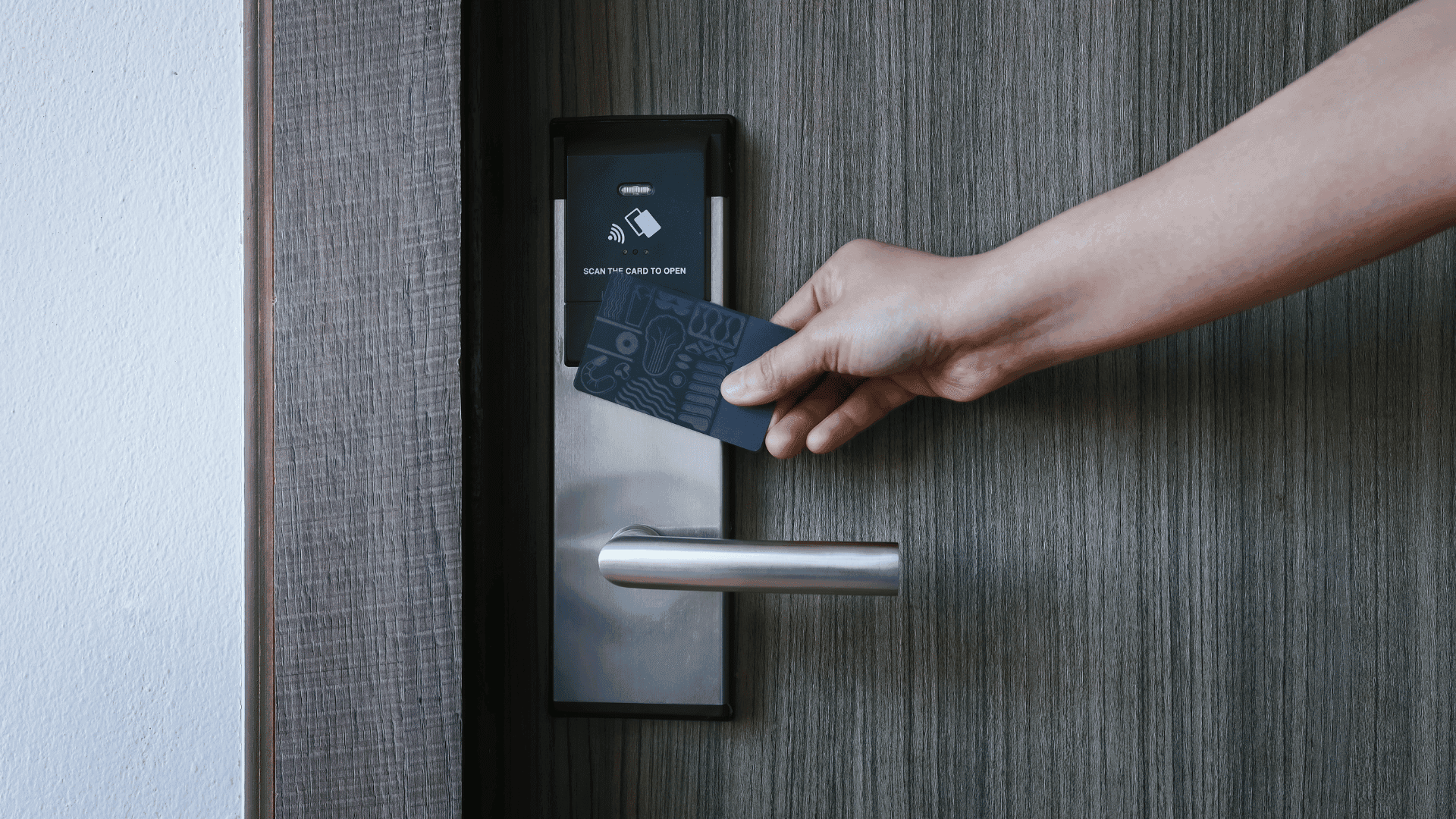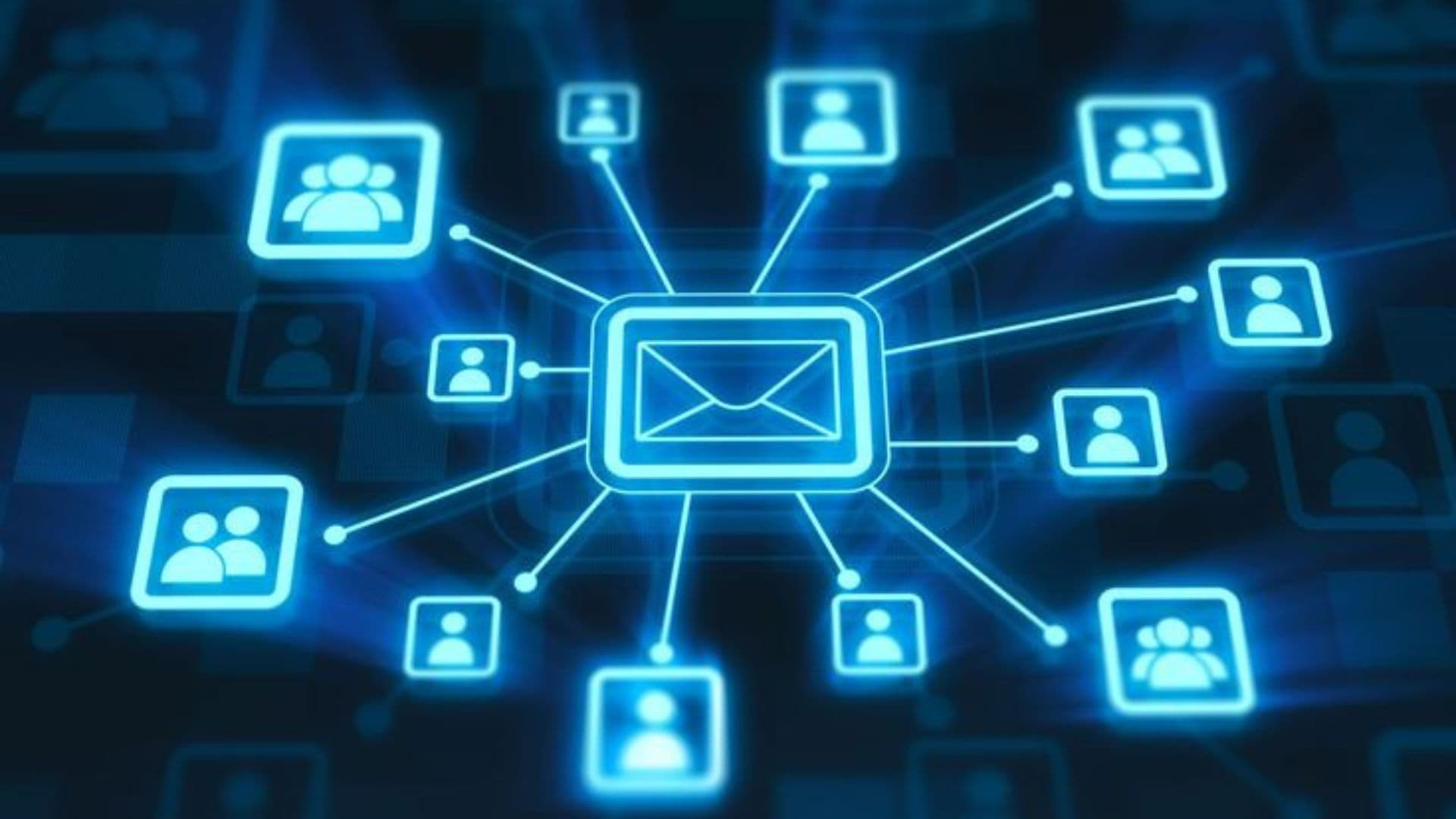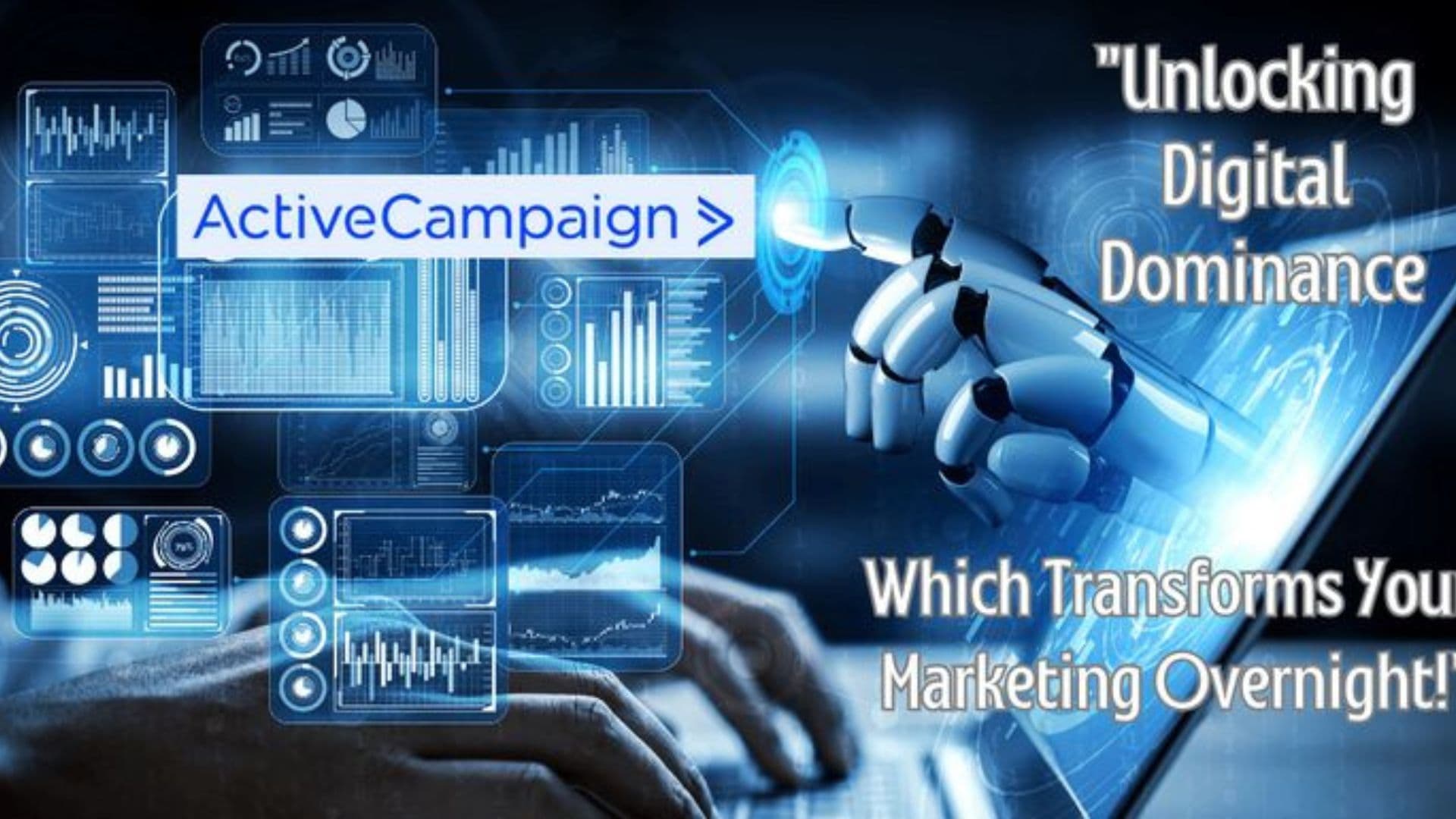Automated Marketing: Ultimate Guide for Maximizing Leads and Growth
Published at 2/14/2024
Alexander Hack
20 mins read

In the marketing world, efficiency transcends mere hard work—it's about smarter strategies. Automated marketing represents this shift, offering a powerful blend of technology and strategy to streamline marketing efforts. It's more than a trend; it's a game-changer for automating tasks and refining strategic initiatives. As we explore automated marketing, we stand on the brink of revolutionizing lead generation and business growth, boasting an impressive average ROI of $5.44 for every dollar spent.
Table of Contents
The sea of digital advancement is vast, but navigating it can be seamless with the right compass. In this step-by-step guide, we'll untangle the complexity of what is marketing automation, illustrating its multifaceted benefits—from implementing efficient campaigns to precision targeting and beyond. I'll share insights into selecting the best marketing automation tools, setting up workflows for optimal engagement, and integrating these systems with your CRM and analytics for a cohesive marketing ecosystem.
While the challenges, such as training and budgeting, are real, I’m here to show how with the proper knowledge and tools, including marketing automation services and b2b marketing automation platforms, we can conquer them, ensuring your marketing and sales teams sail smoothly towards success. Join me as we master the art of automated marketing and transform the way we connect with our audience.
Understanding Automated Marketing
As we delve further into the world of automated marketing, understanding its fundamental concept is key to fully utilizing its capabilities. Commonly known as marketing automation, this technology forms the backbone of contemporary marketing strategies, enhancing our capacity to implement campaigns with unprecedented accuracy. Let's explore this idea further:
- Automated Marketing Defined: Marketing automation fundamentally involves using software to handle routine, repetitive tasks across various inbound channels like email, social media, and contact management. It's not about replacing the marketer, but enhancing their capabilities, freeing up valuable time for developing superior strategies and creative content. The core of marketing automation is to boost efficiency and enable a more personalized interaction with our audience.
- A Catalyst for Lead Generation: Dive into the statistics, and you'll discover that 80% of established companies, that have utilized automated marketing for over three years, report significant revenue increases. This isn't just a coincidence; it's the result of carefully nurturing leads, customizing engagements, and facilitating exceptional consumer interactions—all of which contribute to a substantial increase in ROI. By skillfully using marketing automation tools, we can send targeted messages across various media, accumulating sales leads with remarkable precision.
- Routing the Customer Journey: To effectively utilize automated marketing, it's crucial to focus on the customer journey. We need to identify all possible touchpoints and create processes that smoothly lead customers along this path. Automation isn't just for its own sake; our goal is to provide timely and relevant information through seamless integration between our marketing automation platform and CRM. Despite its numerous benefits, automation is ineffective without a strong inbound strategy fueling the top of the funnel. This shows that the art of automation is as much about strategic groundwork as it is about technical skills.
The journey into automated marketing unfolds with a myriad of tools and strategies at our disposal. It's a journey teeming with potential for both B2B and B2C landscapes, enabling us to infuse real-time relevance into our marketing materials and touch the hearts of our customers more effectively. Next, we'll explore the steps for selecting the ideal marketing automation tool that resonates with our business ethos and customer ethos alike.

What is Marketing Automation?
Step into the world of marketing automation, a landscape where each tool and strategy is like a brushstroke on the canvas of your business's growth. It's the art of turning mundane tasks into a masterpiece of efficiency, a symphony of smart technology tailored to your needs.
The Palette of Processes
Dive into the palette of processes that marketing automation offers:
- Data Collection: Imagine a gallery of insights about your potential clients, each one informing how you engage, like colors blending on a canvas to create the perfect hue.
- Content Creation: Here, you're an artist with words, painting content that speaks directly to the hearts of your audience, aligning with their desires and needs as they journey through the buyer's cycle.
- Targeting & Segmentation: Your campaigns become sculptures, chiseled and defined, targeting the right customers with precision, ensuring not a drop of your resources is wasted on the indifferent.
The journey continues with Campaign Design, where you craft your messages with the creativity of a master painter, each campaign a mural designed to inspire and compel. Workflow Triggers are the baton in the hand of the conductor, leading the orchestra of your marketing channels to play in unison, providing seamless experiences. Finally, Analysis & Tracking is your magnifying glass, the tool that helps you see which brushstrokes captivated the audience and which need a thoughtful rework.
The Mosaic of Benefits
Within this artful endeavor, a mosaic of benefits emerges:
- Conversion Masterpieces: Watch as your customer acquisition rates climb, each new conversion a testament to the precision of your marketing strategy.
- Budget Sculptures: Carve out a marketing budget that is both effective and efficient, ensuring every dollar is spent with intention.
- Productivity Portraits: Your team's workflow becomes a portrait of productivity, freeing up their time to focus on strategy and creativity.
An Anecdote of Transformation
Let me share a personal transformation. Before the dawn of automation, I was a curator in a gallery of chaos, where each marketing effort felt like a random brushstroke on a vast canvas. The introduction of marketing automation was like discovering a new school of art, one where intuition meets information, and every action is deliberate and purposeful. Now, my business is a curated collection of successful campaigns and satisfied customers.
Conclusion: A Visionary Future
Envision a future where the B2B marketing automation market, with its $2.1 billion valuation, is not just a number but a narrative of businesses, including ours, harnessing these tools to not just survive but thrive. Marketing automation is no longer a subset of our operations; it's the visionary artist we partner with to create experiences that resonate and endure.

Unlock Pet Freedom: The Ultimate Guide to Smart Dog Doors
Unlock Pet Freedom: The Ultimate Guide to Smart Dog Doors
Discover how smart dog doors revolutionize pet care, offering freedom for your furry friends and peace of mind for you. Explore the best options, installation tips, and FAQs in our comprehensive guide. Perfect for pet lovers seeking convenience and security.
The Benefits of Implementing Automated Marketing

Incorporating automated marketing into our business operations has yielded significant, measurable benefits, as the data demonstrates. An examination of the impact of marketing automation on productivity and overhead costs reveals a notable 14.5% increase in sales productivity and a 12.2% decrease in marketing overhead. These statistics not only highlight the cost-effectiveness of automated marketing but also its ability to enhance our team's efficiency.
The importance of nurturing leads through marketing automation cannot be overstated. I've witnessed a remarkable 451% increase in qualified leads, which are crucial for not only increasing the likelihood of conversions but also for boosting the purchase size — nurtured leads make purchases that are 47% larger compared to those not nurtured. Moreover, as a direct consequence of automating our marketing operations, we've seen a significant 25% increase in marketing ROI. Additionally, automated marketing tools have enabled us to:
- Simplify the lead scoring process, concentrating efforts on leads that demonstrate a higher propensity to convert.
- Engage in more targeted communication, dividing our audience into segments and delivering bespoke messages that yield a more personalized touch.
- Enhance lead generation and nurturing, ensuring that content reaches prospects at the right stages of their journey, bolstering chances for conversion.
Marketing automation transforms how teams interact with data, enhancing strategic focus and creative freedom. With a unified data source at the core, our marketing team experiences a significant lift in productivity, shifting from manual tasks to strategy-driven projects.
Key Enhancements from Marketing Automation:
- Centralized Insights: A single source of truth for data-driven decisions.
- Strategic Freedom: Liberates creativity for high-value projects.
- Lead Generation: Using Salesforce for superior lead nurturing and tracking.
- Conversion Improvement: Effective journey tracking to boost conversions.
The Impact of Automation on Team Dynamics and Strategy:
Our adoption of automated marketing software, especially Salesforce, has led to a notable improvement in lead generation. This shift from traditional methods to automated solutions allows for large-scale lead acquisition and efficient monitoring throughout the sales funnel.
The customer journey builder feature within our tools offers complete transparency into customer interactions, providing valuable insights that enhance personalization efforts. This level of customization in marketing communications, based on user behavior and demographics, not only elevates productivity but also positively impacts the team's well-being by reducing repetitive tasks.
Automated marketing software elevates our marketing strategy, offering:
- Enhanced Lead Management: Streamlined processes from lead capture to conversion.
- Personalized Customer Experiences: Data-driven insights enable targeted marketing actions.
- Operational Efficiency: Increased team output with reduced manual workload.
- Strategic Campaign Analysis: Easy evaluation of campaign performance for ongoing optimization.
In conclusion, the strategic integration of automated marketing tools reshapes our entire marketing methodology. It extends beyond boosting revenue; it revolutionizes how we approach customer engagement and campaign execution. The clear benefits of marketing automation, evidenced by detailed analytics and data accountability, confirm its indispensable role in today's marketing ecosystem.
Challenges and Considerations in Automated Marketing
As we explore the vast capabilities of automated marketing, including social media marketing, it's crucial to acknowledge the challenges that often come with adopting and implementing these advanced systems. Over half of companies utilize automated marketing for various tasks such as email marketing, social media marketing, and enhancing customer service with automated customer journeys. This indicates the significant prevalence of marketing automation.
However, a considerable portion of these adopters consider themselves as beginners. They find the initial stages of integrating marketing automation, such as setting up automated customer journeys, quite complex and challenging—27% found establishing their platforms for social media marketing and other automation tasks a daunting task.

2024's Best Laptops Revealed: Comprehensive Guide for the Perfect Choice
2024's Best Laptops Revealed: Comprehensive Guide for the Perfect Choice
Discover 2024's top-rated laptops across categories like high-performance, budget-friendly, gaming, and more. Our expert guide offers detailed insights into the latest trends, technical specifications, and essential factors to consider, ensuring you make an informed decision for your next laptop purchase.
Embarking on the Journey of Marketing Automation Setup
Launching into the realm of marketing automation is akin to embarking on a grand voyage across digital seas. The initial setup is crucial, where understanding and strategy intertwine to craft a powerful engine for your marketing efforts. Here's how the journey unfolds:
Navigating the Setup Process
- Charting the Customer's Course: We meticulously map out the customer journey, ensuring each automated workflow is a step on the path to engagement and conversion.
- Crafting the Rulebook: A comprehensive process is documented, establishing clear rules for lead scoring and distribution — the compass for our marketing voyage.
- Seamless Integration: Critical to the journey is the harmonious integration with our existing CRMs and analytics tools, creating a unified command center for our marketing strategy.
The Voyage to a Unified Marketing System
The early stages of setting up our automated marketing system are demanding, yet they pave the way for a formidable framework. Here's a look at the pillars of this framework:
Patience and precision in these initial stages are akin to investing in the finest navigational instruments for a ship. The reward is a robust system tailored to steer sales and marketing towards prosperous shores, invigorated by the promise of efficiency and success.
Master Customer Journey Processes
In the complex process of implementing online marketing automation, it's crucial to focus on training and understanding customer journeys through the use of a customer journey builder. Marketing with Salesforce, known for its customer journey builder feature, or any comprehensive sales marketing automation tool, can be challenging for some. I’ve promoted ongoing education and workshops for my team, encouraging a culture of tech-savviness and innovation to keep everyone updated with the latest online marketing automation concepts and practices.
The complexities of automated marketing software range from understanding the definition of a marketing automation lead to mastering the nuances of customer journeys within the software. It's about devising a strategy for our B2B online marketing automation, figuring out the best use of top automated marketing software, or unraveling the complex workings of the customer journey builder.
We must be aware of these challenges as they often test and refine the effectiveness of our marketing automation lead generation. As we progress towards more complex customer journey strategies, such considerations become crucial for developing a dynamic and responsive online marketing automation service, aimed at expanding our business's reach.
Selecting an Appropriate Marketing Automation Platform
When selecting a marketing automation platform, businesses should seek a solution that serves as a dependable partner throughout their growth journey. The choice necessitates a systematic approach, with thorough consideration given to several key factors:
- Functional Necessities: Identify the essential features such as lead generation and management functions.
- Scalability: The platform must accommodate business growth without necessitating a future system change.
- User Interface and Reporting: A straightforward user interface and comprehensive reporting tools are vital for operational efficiency.
- Market Position: Research the market standing and customer feedback of potential platforms to ensure long-term service reliability.
- Integration: The platform should integrate seamlessly with existing CRM systems and other tools for a cohesive marketing approach.
- Cost Considerations: Understanding the pricing structure, including any setup fees and scalability of costs, is essential for budgeting.
In the process of selection, we have discerned the following insights:
- Automated marketing platforms are reported to increase lead generation by up to 80%.
- These tools can also contribute to a 451% increase in the generation of qualified leads.
- Post-implementation, a significant increase in conversion rates is often observed.
Here is a concise overview of the key considerations:
The decision-making process involves evaluating the features against the business's current and future needs, ensuring the platform will be a long-term asset.
In conclusion, our selection from renowned names in the industry—such as Adobe, HubSpot, Oracle, Microsoft, Salesforce, and SAP—will be critical. The chosen platform must not only satisfy immediate requirements but also adapt to future challenges, embodying the essence of what effective marketing automation stands for.
Leading Automated Marketing Tools for Today's Businesses
In the realm of automated marketing, staying ahead means leveraging the best tools the market offers. These platforms not only streamline operations but also open doors to innovative strategies for businesses of all sizes. Below, we explore the forefront of automated marketing tools, each renowned for its unique strengths and capabilities:
Current Market Leaders
- HubSpot: HubSpot stands as a beacon for businesses seeking an all-encompassing marketing suite. Its integration capabilities across CRM, email marketing, and content management systems make it a versatile choice for enhancing customer relationships and automating marketing workflows.
- ActiveCampaign: Known for its advanced email marketing and automation capabilities, ActiveCampaign excels in delivering personalized customer experiences. Its CRM functionality further aids in nurturing leads through detailed segmentation and targeted campaigns.
- Sendinblue: Sendinblue offers a robust platform for businesses prioritizing email marketing, SMS campaigns, and chat services. Its affordability and scalability cater to the growing needs of small to medium-sized enterprises, making it a practical choice for budget-conscious marketers.
- ConvertKit: Tailored for creators and small businesses, ConvertKit facilitates direct engagement with audiences through simplified email marketing and automation processes. Its ease of use and focus on growth metrics make it a favorite among entrepreneurs and content creators.
- GetResponse: GetResponse is celebrated for its multi-functional marketing capabilities, including automated workflows, email marketing, and landing pages. Its comprehensive approach to lead generation and conversion appeals to marketers looking for an all-in-one solution.
- Pardot by Salesforce: For enterprises aiming at sophisticated marketing automation aligned with sales efforts, Pardot offers a seamless solution. Its integration with Salesforce enhances lead management and scoring, supporting a unified marketing and sales strategy.
- Autopilot: Autopilot’s visual marketing automation and customer journey mapping features stand out for designing personalized experiences. Its user-friendly interface enables marketers to craft intricate customer journeys with ease.
- Marketo: A powerhouse in the field of marketing automation, Marketo provides extensive tools for email marketing, lead management, and analytics. Its capabilities cater to large enterprises looking for a comprehensive marketing platform.

Ultimate Guide to the Best Smart Locks for Front Doors 2024: Top Picks & Expert Reviews
Ultimate Guide to the Best Smart Locks for Front Doors 2024: Top Picks & Expert Reviews
Discover the latest in home security with our comprehensive guide to 2024's top smart locks for front doors. Learn about the Schlage Encode, Wyze Lock, August Smart Lock Pro, ULTRALOQ U-Bolt, and Yale Assure Lock SL. Get insights on installation, app integration with Yale Home, Nuki Web, and more for enhanced home safety.
Choosing the Right Tool
Selecting the appropriate automated marketing platform is a strategic decision that impacts the trajectory of your marketing efforts. It's essential to consider your business size, budget, and specific marketing goals when evaluating these tools. The right platform should not only meet your current needs but also scale with your business as it grows.
Summary Table of Leading Tools
In the dynamic landscape of digital marketing, these tools offer the capabilities to not only automate tasks but also to deepen connections with audiences through personalized interactions. As we embrace these technologies, the essence of marketing automation evolves, enabling businesses to achieve unprecedented levels of efficiency and engagement.
Streamlining Efficiency: Crafting Your Marketing Automation Workflow
The development of a marketing automation workflow is a strategic initiative that transforms a series of marketing tasks into a streamlined, automated process. This process not only optimizes your marketing team's efficiency but also brings precision and personalization to your customer engagement strategies. Below, we outline the steps to establishing a workflow that enhances both operational efficiency and customer interaction:
Workflow Foundation
The initiation of a successful marketing automation workflow begins with a thorough analysis of your marketing strategy to identify tasks suitable for automation. These tasks can vary from straightforward activities like email dispatches to more intricate processes such as lead scoring and customer segmentation. Recognizing the complexity and requirements of these tasks allows for the creation of a unified, effective workflow.
Core Components of an Automated Workflow

- Triggers and Actions: At the heart of automation are triggers—specific customer actions or behaviors that initiate a sequence of predefined responses. These could include actions like signing up for a newsletter, viewing a product, or abandoning a shopping cart, with corresponding responses designed to engage the customer further.
- Time Controls: Implementing time-based triggers ensures that responses are not just event-driven but also timely. For instance, sending a follow-up email a set number of days after a purchase or reminding customers about an expiring offer.
- Conditional Logic: Conditions or criteria that determine the path of the automation, such as sending different follow-up emails based on whether the previous one was opened.
- Engagement Tracking: Utilizing automation tools to monitor customer interactions and tailoring responses to enhance engagement and move leads through the sales funnel more effectively.
Implementing Effective Marketing Workflows
- Welcome Series: A sequence of automated emails welcoming new subscribers, introducing them to the brand, and laying the groundwork for ongoing communication.
- Cart Abandonment Reminders: Automated reminders sent to customers who have left items in their cart, personalized to encourage completion of the purchase.
- Lead Nurturing Sequences: A series of targeted communications providing educational content, updates, and offers to keep leads engaged and advance them through the sales funnel.
Leveraging Tools for Enhanced Automation
Platforms like Coupler.io have been instrumental in refining our data collection and analysis, facilitating informed, data-driven marketing decisions. Moreover, solutions such as HubSpot have transformed our approach to email marketing and lead management, embodying the essence of marketing automation by aligning with our strategic goals.
The Impact of a Well-Defined Marketing Automation Workflow
The introduction of a carefully planned marketing automation workflow has greatly improved our operational efficiency and customer satisfaction. It has led to a noticeable increase in lead generation and conversion rates, which directly boosts our bottom line. Marketing automation has evolved beyond just an efficiency tool, becoming a crucial strategic asset in our digital marketing toolkit, fostering growth and innovation.
In summary, the strategic design and implementation of marketing automation workflows are critical in the current digital marketing environment. By adopting these automated processes, companies can not only save time but also generate more impactful, personalized customer experiences that enhance engagement and revenue.
Elevating Marketing Impact with Automated Strategies
The implementation of automated marketing strategies represents a pivotal shift in how we approach engagement and growth. Through the strategic use of automation tools, we not only enhance our interactions with prospects but also streamline our marketing operations to cultivate customer loyalty and drive business success. Here's a refined approach to deploying these strategies effectively:
Strategic Foundations for Automation
- Goal Setting: Establishing clear, measurable goals is the first step in our journey, providing a roadmap for our marketing automation endeavors. These goals, whether aimed at increasing engagement, improving lead quality, or boosting conversions, inform the direction of our campaigns.
- Understanding the Audience: A deep dive into our audience's online behaviors and preferences enables us to tailor content that meets their needs and captures their interest, ensuring timely and relevant communication.
Personalizing the Customer Experience
- Customized Customer Journeys: Beyond generic pathways, we use marketing automation to deliver personalized experiences. By segmenting our audience and optimizing engagement timings, we transform interactions into impactful moments that encourage loyalty.
- AI-Driven Optimization: Leveraging AI allows us to refine campaign elements dynamically, enhancing content relevance and engagement potential through targeted keywords and compelling messaging.
Nurturing and Prioritization
- Automated Lead Nurturing: Our strategy encompasses a continuum of automated communications designed to build relationships over time, guiding prospects through the awareness and decision-making phases with tailored content.
- Lead Scoring Models: By employing clear scoring criteria, we focus our attention on leads showing readiness for engagement, ensuring a more efficient allocation of resources.
Responsiveness and Analysis
- Trigger-Based Messaging: Utilizing user actions as triggers, we deliver content and responses that resonate with individual interests, driving deeper exploration and conversion opportunities.
- Iterative Improvement through Analytics: Continuous evaluation of campaign performance allows us to refine our strategies, leveraging insights from engagement metrics to enhance future outcomes.
Choosing the Right Tools
Our toolkit includes leading platforms that align with our strategic needs, from comprehensive solutions like HubSpot and Adobe Marketo Engage to specialized offerings such as Salesforce Marketing Cloud Account Engagement for intricate B2B dynamics. Oracle Eloqua stands out for its advanced personalization and lead management features, while platforms like ActiveCampaign and EngageBay present cost-effective yet feature-rich options for businesses exploring automated marketing.
Conclusion
Adopting automated marketing strategies goes beyond the selection of sophisticated tools; it signifies our commitment to innovative engagement techniques that prioritize efficiency, personalization, and strategic growth. By integrating these principles into our marketing efforts, we not only streamline our workflows but also create a more meaningful dialogue with our audience, setting the stage for sustained business success.
Best Practices for Maximizing ROI with Automated Marketing
In my quest to master automated marketing, I've discovered that maximizing ROI is not just about leveraging technology but strategically using it to amplify marketing outcomes. With lead generation growing in complexity and content creation demanding more time, it's crucial to integrate marketing automation systems to create a seamless flow of information. Doing so combines lead data across multiple channels, enhancing efficiency and engagement while improving conversion rates. Having implemented marketing automation in my strategy, here are the best practices I've applied to turbocharge ROI:
- Metrics Monitoring: Keeping a pulse on key metrics is imperative. These include:
- Conversion Rate: A direct reflection of how effectively marketing automation turns prospects into customers.
- Lead Quality & Customer Acquisition Cost (CAC): Balancing the quality of leads against the cost of acquiring them is fundamental in evaluating the success of my automated marketing campaigns.
- Cart Abandonment Rate: Reducing this rate with automated reminders or personalized offers directly impacts revenue.
- Multi-Channel Coordination: Efficiency soars when marketing automation seamlessly interacts with customers across all channels by:
- Utilizing a customer’s data from various sources to analyze behavior and requests.
- Adding them to the appropriate audience segments and using that data to recommend products or services intelligently.
- Data-Driven Personalization: Harnessing real-time data updates is a game-changer. For instance:
- List Management: Excluding a customer from an acquisition campaign automatically after a conversion results in more focused efforts and cost-efficiency.
- Personalized Messaging: Crafting customized content based on updated audience segmentation ensures relevance, fostering loyalty and repeat business.
To reap the benefits of automation, please be sure to steer clear of pitfalls like using poor-quality data or not using all relevant channels. Instead, embrace the power of a Customer Data Platform (CDP) that collects and centralizes data from multiple sources. This integration with various marketing software platforms is a golden ticket to running omnichannel marketing campaigns that are rich with insights and tailored to each customer segment.
Furthermore, I prioritize continuous optimization through strategic actions:
- Lead Scoring: Develop a robust scoring system that identifies the most promising leads for personalized follow-up.
- Behavioral Triggers: Use customer behavior to set off bespoke automated marketing responses that drive engagement and sales.
Maximizing ROI with automation isn't only about implementing technology; it's about adopting an attitude of perpetual refinement and adaptability, keeping abreast with the evolving digital landscape, and ensuring we're automating the right elements. As we integrate marketing automation with CRM and harness the analytics from platforms like HubSpot, we gain clarity on revenue influence and the direct impact of each marketing campaign—crucial insights that feedback into a cycle of continuous improvement and strategic growth.
Harmonizing CRM and Analytics with Automated Marketing

The integration of Customer Relationship Management (CRM) and analytics into our automated marketing strategy marks a significant advancement towards creating a cohesive and efficient marketing ecosystem. This strategic alignment has been instrumental in eradicating data discrepancies and ensuring consistent messaging across all customer touchpoints. By consolidating customer data into a singular system, we've enhanced our ability to manage, analyze, and leverage information effectively, enabling a deeper understanding of customer behaviors and driving stronger relationships.
Streamlining Operations with CRM Integration
Our commitment to a collaborative marketing strategy has led us to integrate sophisticated CRM systems, such as Agile CRM, with our marketing automation efforts. This integration bridges the gap between sales, service, and marketing teams, promoting unity and shared responsibility. Agile CRM, with its comprehensive suite including contact management, marketing automation, and analytics, exemplifies our approach to offering a versatile yet affordable solution for managing customer relationships and marketing campaigns under one umbrella.
Establishing Integration Guidelines for Success
To maximize the benefits of integrating CRM and analytics with automated marketing, we've developed a set of guidelines:
- Integration Objectives: Setting clear goals for the integration ensures that every action, from enhancing data synchronization to fostering team collaboration, aligns with our overarching business goals.
- Data Flow Mapping:
- Identifying Essential Data Points: Careful selection of data for synchronization between CRM and marketing automation platforms ensures relevance and efficiency.
- Planning Data Mapping: A detailed data mapping strategy facilitates smooth data transfer, optimizing usage and minimizing confusion.
- Data Synchronization:
- Configuring Settings: Adjustments to configuration settings enable a bidirectional flow of data, maintaining consistency across systems.
- Maintaining Regular Updates: This practice ensures that the information remains current across all platforms, enhancing the accuracy of customer interactions.
Leveraging Integrated Tools for Enhanced Campaigns
This holistic approach not only streamlines lead generation and sales optimization but also enriches our customer engagement strategies. By operating in unison, CRM systems remember past interactions, while marketing automation anticipates future needs, creating a dynamic dialogue with our audience. Employing integrated analytics, we continuously assess the impact of our marketing initiatives, refining our tactics for better outcomes.
Platforms like HubSpot, Moosend, and Rejoiner exemplify the seamless integration of CRM and marketing automation, enabling us to make informed, data-driven decisions. These tools empower us to customize our marketing efforts, ensuring they resonate with our target audience and operate at maximum efficiency.
In conclusion, the integration of CRM and analytics with automated marketing is not just an operational enhancement—it's a strategic imperative. It transforms our marketing approach into a data-informed dialogue with our customers, paving the way for more personalized, effective, and efficient marketing campaigns.
The Role of AI in Enhancing Automated Marketing
In conclusion, we've explored the transformative world of automated marketing, highlighting its crucial role in modernizing lead generation and promoting business growth. Our journey, from choosing the right marketing automation platform to carefully designing workflows and strategies, has shown the significant impact of adopting such technologies. The integration of marketing automation tools with CRM and analytics has not only simplified operations but also improved the customer experience and team coordination—significantly affecting our ROI and creating a more connected and insightful business environment.
Our findings' importance goes beyond mere numbers, indicating the future of marketing where efficiency, personalization, and smart engagement are key. As digital advancements keep shaping the industry, the practices we've discussed here can serve as a guide for those aiming to fully utilize automated marketing. Although the journey of discovery and refinement in automation continues, the strategies and insights shared provide a foundation for ongoing innovation and success in a world where marketing is not just automated, but also skillfully executed.

Unleashing Smart TVs: An In-Depth Guide to the Best Models and Their Noteworthy Features
Unleashing Smart TVs: An In-Depth Guide to the Best Models and Their Noteworthy Features
Explore the world of Smart TVs with our comprehensive guide to the Best Models of 2024. Discover essential features, user reviews, and tips for choosing the right Smart TV. Learn about 4K, OLED, QLED TVs, streaming services, and privacy concerns. Perfect for tech enthusiasts and potential buyers seeking the latest in home entertainment.
Conclusion
B2B marketing automation ushers in a new phase of sales and marketing collaboration. It streamlines customer identification, emphasizes personalized emails, and introduces time-saving features for precise message delivery. The focus is on nurturing leads to the core of our business, transforming every customer interaction into a step towards a more tailored experience. Key elements of a B2B marketing strategy include:
- Improving lead generation and nurturing for higher conversion rates,
- Unifying sales and marketing teams for a unified effort,
- Encouraging data-driven decision-making for targeted strategies.
Our goal to optimize ROI with automated marketing funnels isn't a random endeavor—it's a calculated journey involving predictive analytics, detailed customer journey maps, and continuous strategy refinement. We're committed to identifying where prospects disengage and rigorously testing to fine-tune our messages. We're also adopting customer retention automation to convert occasional buyers into passionate brand advocates. This process involves mapping customer lifecycle stages and setting up behavior-triggered campaigns that integrate smoothly with loyalty programs, all while closely monitoring retention metrics.
Implementing these strategies requires a detailed and collaborative approach, with a relentless focus on specifics—like building extensive contact databases and developing robust lead-scoring models. It's a joint effort, merging marketing automation with CRM and analytics to capture the full extent of customer engagement. This ushers in a new era of business intelligence powered by data-driven training for marketing teams. Collectively, these components pave the way to mastering automated marketing—a journey that promises not just success, but a transformation in how we approach our digital marketing efforts.

The Unseen Side of Fixed Lighting: When 'Not Dimmable' Makes Sense
The Unseen Side of Fixed Lighting: When 'Not Dimmable' Makes Sense
Discover the best lighting for your space with our 2024 guide on dimmable and non-dimmable lights. Compare top picks like Philips Hue and others to make an informed choice between dimmable and 'not dimmable' options. Your journey to the perfect lighting starts here.
FAQs
In the constantly changing world of automated marketing, I frequently come across numerous inquiries about its complexities and uses. To clarify and simplify this digital marketing approach, let's explore some of the most common questions:
What exactly is marketing automation?
Marketing automation is a sophisticated digital marketing strategy that relies on software to deliver personalized messaging, streamlining the nurturing of leads through various stages of the sales funnel. It's about creating a more personalized and timed approach with each prospect, enhancing the likelihood of conversion.
How does marketing automation benefit my business?
Let me share some undeniable advantages:
- Time and Cost Savings: It reduces manual effort, allowing our team to allocate more time to strategic initiatives.
- Efficiency in Conversions: Automates lead nurturing precisely catered to a lead's position in the sales funnel, resulting in higher conversion rates.
- In-depth Analytics: Armed with marketing automation tools, we gain actionable insights and improve performance through real-time data and detailed analytics.
What are Automated Market Makers (AMMs)?
Automated Market Makers are algorithmic agents used in the context of cryptocurrency and decentralized finance (DeFi) to facilitate trading by automatically providing liquidity on both sides of a trade based on pre-set rules.
What does marketing automation entail?
Marketing automation involves the use of software and technologies to automate repetitive marketing tasks, streamline marketing workflows, and measure the outcomes of marketing campaigns, making operations more efficient and personalized.
How does email marketing work?
Email marketing works by sending targeted, personalized messages to a list of email subscribers to promote a product, service, or content, with the aim of engaging potential and existing customers in a cost-effective manner.
What email marketing service is best?
The best email marketing service depends on your specific needs, but services like Mailchimp, ActiveCampaign, and Sendinblue are highly regarded for their comprehensive features, scalability, and user-friendly interfaces.
What email marketing should I use?
Choose an email marketing platform that aligns with your business size, marketing goals, and budget. Consider factors like ease of use, automation capabilities, integration options, and analytics when making your decision.
Why is email marketing effective?
Email marketing is effective because it allows for direct, personalized communication with your audience at a relatively low cost. It offers measurable ROI, high engagement rates, and the ability to segment and target specific groups of customers.
Why is email marketing the future?
Email marketing remains a critical component of digital marketing strategies due to its adaptability, effectiveness in building relationships, and potential to leverage AI and machine learning for even more personalized and impactful campaigns. As digital communication evolves, email marketing continues to offer a direct line to customers, making it an enduring and evolving tool for businesses.

Ultimate Guide to Smart Doorbells 2024: Solving Common Issues and In-Depth Comparisons
Ultimate Guide to Smart Doorbells 2024: Solving Common Issues and In-Depth Comparisons
Explore our comprehensive guide to the best smart doorbells of 2024. Get expert insights on resolving issues like the Nest doorbell not ringing on phone, linking Ring to Google Home, and more. Discover detailed comparisons, installation tips, and the latest features for enhancing home security and convenience.